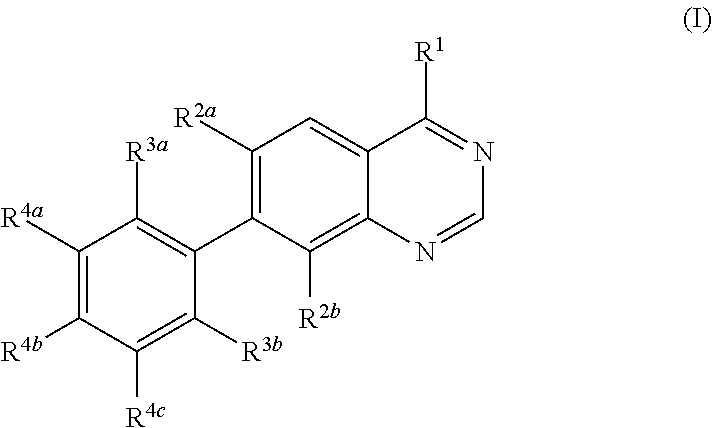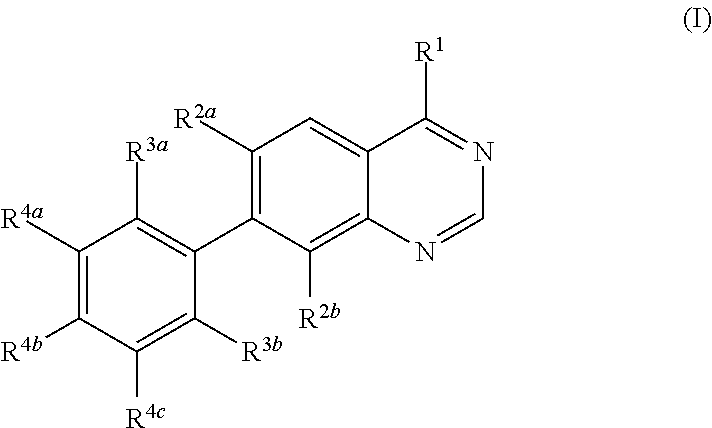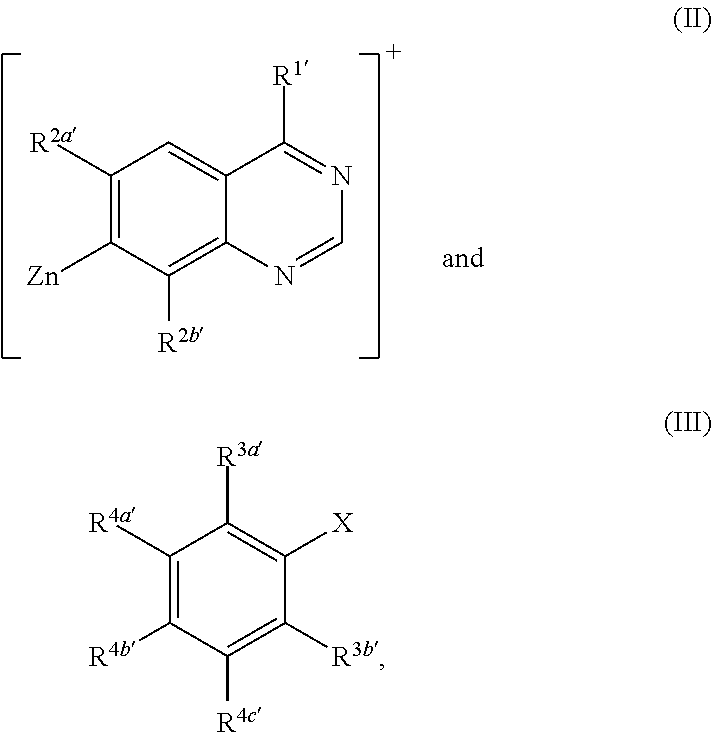Methods for preparation of quinazoline derivatives
a quinazoline and derivative technology, applied in the field of methods and compounds for preparing quinazoline and quinazoline derivatives, can solve the problems of inability to accurately predict, relatively new and unpredictable synthetic methodologies, and inability to achieve accurate prediction, etc., to achieve efficient and amenable effects
- Summary
- Abstract
- Description
- Claims
- Application Information
AI Technical Summary
Benefits of technology
Problems solved by technology
Method used
Image
Examples
example 1
Preparation of Compound 2
[0096]
[0097]In a 4-neck, 3 L, round-bottom flask with a magnetic stir bar, compound 1 (82.47 g, 0.4153 mol, 1 equiv), BOP (201 g, 0.4544 mol, 1.1 equiv), and DBU (78.8 mL, 0.5272 mol, 1.3 equiv) were slurried in THF (2.1 L). After 30 minutes, N-Boc-piperazine (100 g, 0.5368 mol, 1.3 equiv) was added. The reaction mixture was stirred at 70° C. overnight to form a dark solution. The reaction was concentrated to one half volume via rotary evaporator, quenched with water (600 mL), then extracted with EtOAc (3×400 mL). The combined organic layers were dried (Na2SO4) and concentrated to an oil. The dark oil was stirred in 1:1 EtOAc / Et2O (700 mL) overnight to form solids. The solids were filtered to recover 90 g of crude 2. The impure product was slurried overnight in warm EtOAc (700 mL) then filtered to recover 10 g of starting material 1. The filtrate was then concentrated and slurried in 3:1 EtOAc / Et2O (300 / 100 mL) overnight. The solids were filtered and washed ...
example 2
Preparation of Compound 4
[0098]
[0099]A dried 3 L, 3-neck flask (evacuated under vacuum and filled with N2 three times) was fitted with mechanical stirring, temperature probe, and nitrogen inlet and charged with tert-butyl 4-(6-chloro-8-fluoroquinazolin-4-yl)piperazine-1-carboxylate 2 (100 g, 272.6 mmol) and dry THF (1 L). Bis(2,2,6,6-tetramethylpiperidinyl)zinc, lithium chloride, magnesium chloride complex ((TMP)2Zn.2MgCl2.2LiCl) (778.9 mL of a 0.35 M solution in THF / toluene, 272.6 mmol) was added via addition funnel over 10 minutes. The reaction was allowed to stir for 45 min at room temperature then degassed by bubbling nitrogen through the solution for 15 minutes. Solid 2-bromo-1-fluoro-3-methoxybenzene (55.9 g, 272.6 mmol) and CPhos 3rd generation precatalyst (17.6 g, 21.8 mmol) were added, and the mixture was heated to 40° C. for 12 h. The reaction was cooled in an ice bath and slowly quenched with 1.5 L of a 1:1 solution of saturated ammonium chloride and H2O. The layers were ...
example 3
Preparation of Compound 5
[0100]
[0101]A 5 L, multi-neck, jacketed reactor with bottom valve was purged with N2 and charged with tert-butyl 4-(6-chloro-8-fluoro-7-(2-fluoro-6-methoxyphenyl)quinazolin-4-yl)piperazine-1-carboxylate 6 and CH2Cl2 (1260 mL). The mixture was cooled to −10° C. Neat BBr3 (106 mL, 1.1 mol, 6 equiv) was added in a slow stream via syringe over 11 min causing immediate precipitation of a tan solid and an exotherm to 3° C. After addition was complete, the reaction was warmed to room temperature, and the suspension was stirred for 19 h. HPLC analysis indicated good conversion to the desired piperazine intermediate 5 with just a small amount of methyl ether remaining. The reaction was cooled to −10° C. and very carefully quenched with an ice / water mixture (1 kg).
PUM
 Login to View More
Login to View More Abstract
Description
Claims
Application Information
 Login to View More
Login to View More - R&D
- Intellectual Property
- Life Sciences
- Materials
- Tech Scout
- Unparalleled Data Quality
- Higher Quality Content
- 60% Fewer Hallucinations
Browse by: Latest US Patents, China's latest patents, Technical Efficacy Thesaurus, Application Domain, Technology Topic, Popular Technical Reports.
© 2025 PatSnap. All rights reserved.Legal|Privacy policy|Modern Slavery Act Transparency Statement|Sitemap|About US| Contact US: help@patsnap.com



